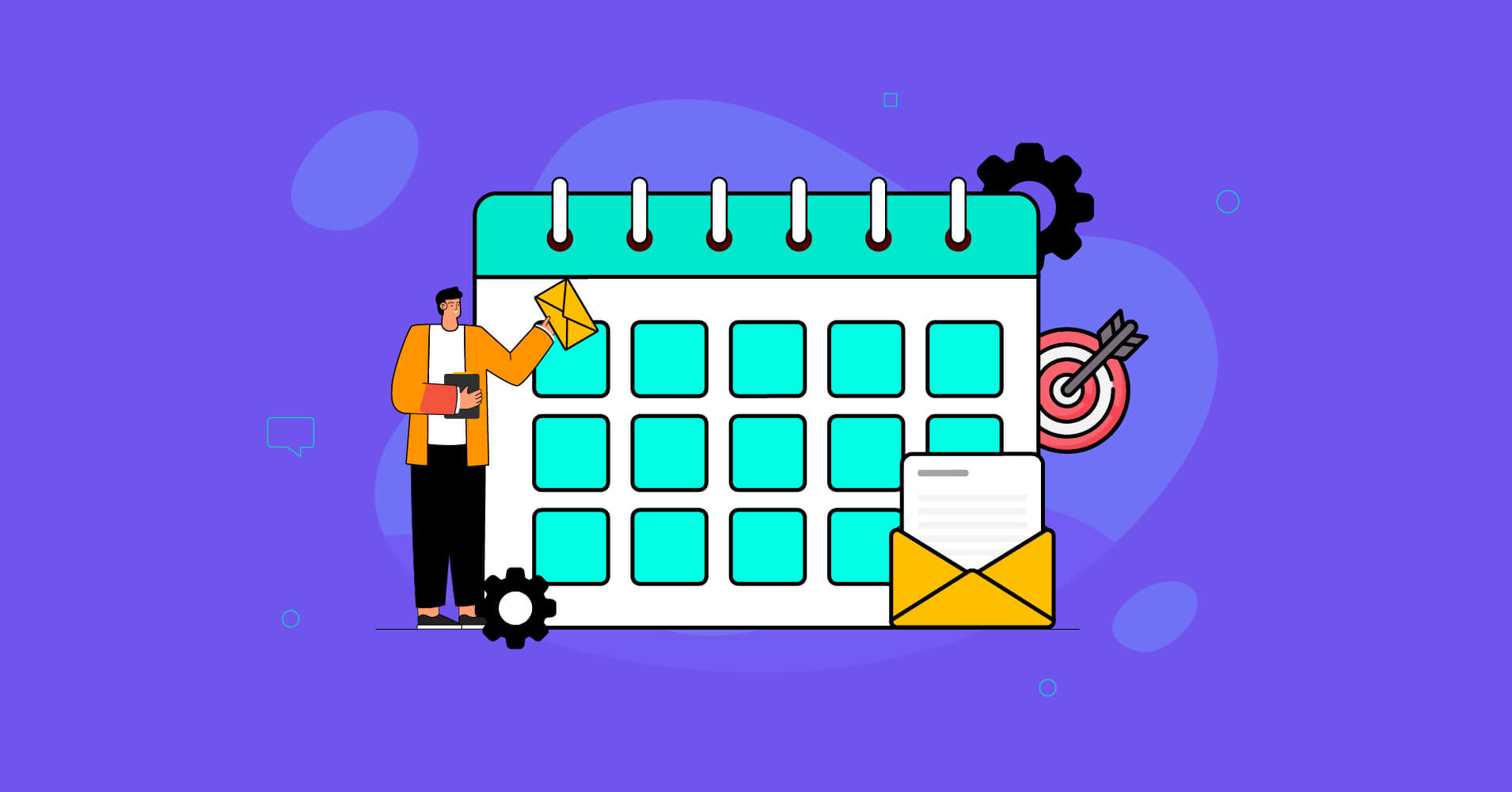
10 Email Frequency Best Practices: How Often and When Should You Send Emails?
Every email marketer understands the value of email marketing, but most struggle to find the right frequency of sending emails.
Send too many emails, and the unsubscribe rate increases. Send too few emails, and subscribers will forget about you.
So, if you’re asking how often you should email to preserve your subscribers’ interest without annoying them, you’re in the right place. In this piece, we’ll explore email frequency best practices, how many emails you should send your subscribers, and how often.
Best Practices of Email Frequency: A Quick Overview
- Best days to send emails are on Monday, Tuesday, and Friday
- Best time to send emails is between 9 A.M to 3 P.M
- Professional users are generally active between 11 A.M to 1 P.M
- Good email cadence for B2B is 2 emails/month, and B2C is 4 emails/month
- Let the audience choose their preferred email frequencies
- Unsubscribe rate of more than 0.3% indicates something is wrong
- Segment your users depending on behaviour, gender, and geographic location
- Measure your audience’s email KPIs regularly
- A/B test your email contact list to find out the best CTR of your audience
- Clean your contact list regularly to keep your email engagement high
- Automate your emails to ease your manual tasks and focus more on strategies
What are the Key metrics for determining email frequency?
The key metrics you should analyze before deciding on your email frequency are: click rate, click-through rate, conversion rate, unsubscribe rate, and ROI.
The best way to understand whether your emails are working or not is to look at your recipients’ activity through email marketing metrics.
Here’s a study that shows how most marketers evaluate an email campaign’s efficiency:
However, when it comes to evaluating your email campaign’s performance to identify an ideal email frequency, you can confidently rely on the following two metrics:
Open rate
Although open rates decreased due to Apple’s Mail iOS 18 update, and Google and Yahoo’s new email deliverability rules, it is still a fantastic indicator if you’re using a system that can understand the difference between machine opens and human opens.
The open rate can help you understand when most recipients open your emails. As a result, it can be a good metric to determine if you’re sending the right amount of emails or at the right time.
Click-through rate(CTR)
While opens indicate whether your emails are getting read or not, CTR indicates how effective the email is. Yes, it’s the ultimate metric for determining the right email frequency. More clicks mean higher conversion rates.
If your email is earning you a good CTR, congratulations, you’re sending the right number of emails! But if your emails aren’t getting the proper attention, then it’s a red signal.
Jump into this guide and improve your email click-through rate for increased conversion
10 email frequency best practices to follow
While open rates and CTR can indicate whether you’re sending emails at the ideal frequency, this can vary depending on the industry you’re in.
In order to achieve your ideal email frequency, you can follow the tips we’re sharing below:
Understand your audience
A thorough understanding of your target audience will help you stay ahead of the competition. Investigate your recipients’ actions, determine when they favor opening their inboxes, and try to identify the characteristics of your recipients.
Design your email marketing strategy around your audience’s needs and provide answers they want to hear.
Explain your intention
Instead of letting your audience get lost in a desert of annoyance, directly inform them of the service you’re providing and the number of emails you’ll send each week.
We advise that you let each new subscriber know how frequently you’ll send emails. They’ll be aware of your policy from the start and won’t be exhausted later. Allow them to choose the number and frequency of emails they want to receive.
We assure you, this will improve your company’s credibility and positively influence your audience!
Segment your contact
It’s natural for your email list to contain a variety of people of varying ages and genders, and not all of them are undergoing the same problem.
This is why you must prioritize segmenting if you don’t want to see a hike in unsubscribe rate, even worse: increasing Spam reports!
Segment your contacts based on their needs, age, gender, etc., and try to provide something that they truly desire.
To learn more about effective segmentation strategies, read this blog!
Use a marketing automation tool
No matter how committed you are to creating an email list, manually segmenting recipients, and sending emails frequently, you will eventually get tired at some point. But what would be the effects?
Well, it’ll significantly hamper your consistency and slow your marketing process. That’s why we always encourage our audience to use an efficient marketing automation tool.
An email automation tool will assist you in :
- Gathering leads from various sources
- Segmenting your subscribers into different groups
- Sequencing your emails exactly how you want
- Automating your entire email-sending process using the right frequency
- Obtaining the necessary data to run a successful campaign
- A/B testing your email procedure
FluentCRM can be your go-to option to collect leads, segment them using tags/lists, automate your conversation with powerful funnels, and build and grow your business with high conversion & stable customer management.
Allow the recipients to decide
Do you know what the best solution for every problem is? Discussion!
Pass the ball to your recipient’s court and let them decide what they want. Simply ask your subscribers to select the email frequency they are comfortable with, and you’ll gain their trust!

If you’re using FluentCRM, you can dynamically tag the audience based on their choice and send emails based on their chosen frequency.

Be consistent
Email marketing does not require much effort at once; however, what it requires is a consistent effort.
Consistent email sending is critical for the following reasons:
- It won’t let your subscribers forget about you
- It’ll assist you in keeping your email list clean by allowing you to remove inactive users at regular intervals
- Consistent communication will keep you at the top of your subscribers’ minds
Recognize the differences in B2C and B2B email frequency
Email recipients are roughly divided into two groups: businesses and customers. And you must use two distinct approaches when sending emails to these two distinct groups.
B2B and B2C demand different email cadences and different types of content. The key points you should maintain for B2B and B2C email content are given below:
| Aspect | B2B Email Frequency | B2C Email Frequency |
|---|---|---|
| Typical Frequency | 2 emails/month (bi-monthly) | Weekly to 2–4 times/week |
| Content Style | Long, detailed (e.g., case studies, info based) | Short, visual, promo-focused |
| Engagement Goal | Nurture relationships, support long sales cycles | Drive quick purchases, repeat sales |
| Over-emailing Risk | More than 2/week may annoy busy pros | More than 4/week risks fatigue |
When sending B2B emails, try to act professionally. We recommend that you send B2B emails no more than twice a month.
Examine industry averages
Don’t be disheartened by your clients’ responses compared to other industries. Email metrics such as open rate, click rate, and click-through rate can vary depending on the industry.
Maybe the responses you’re getting are ideal for the industry in which you work.
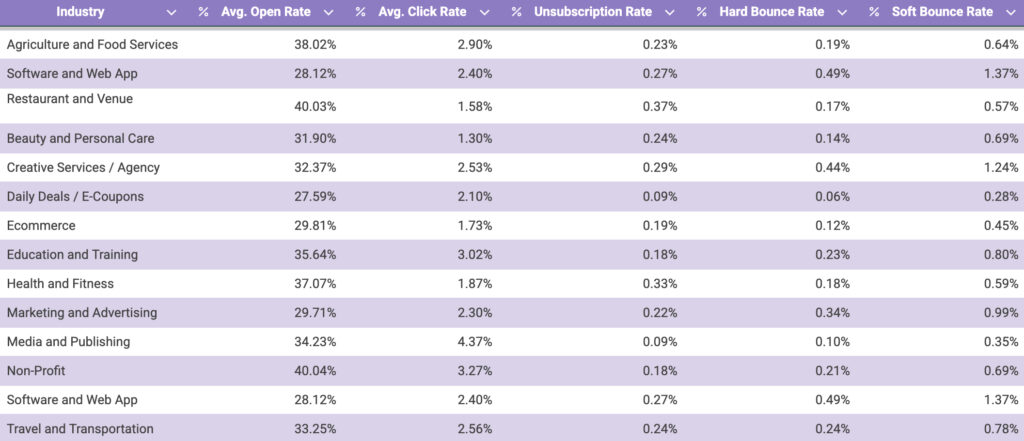
Determine the optimal number for your industry and adapt your email sending best practices accordingly.
A/B test email frequency
It’s best to find the ideal email frequency yourself. Remember that everyone has unique email inbox opening habits, and it’s natural for your subscribers to differ.
To determine the best email frequency practices, we recommend that you A/B test your frequency. Run multiple email campaigns at various frequencies, compare the metrics of these email campaigns, and see which works best for your recipients!
Analyze the metrics correctly
You and only you, can determine your best frequency by examining data. Develop an email frequency strategy that is ideal for you by paying close attention to the metrics.
Any misunderstanding could seriously mislead you, rendering your entire email-sending effort useless.
What is the best time to send an email?
The best time to send emails is when it’s convenient for your subscribers. The aspects you must consider are niche, time zone of your audience, subscribers’ email usage patterns, your usual email cadence if you want to understand the ideal time for sending your emails.
Now, let’s look at the statistics from the survey on marketing professionals and industries to answer the question better.
What is the best day to send an email?
According to the survey of marketing professionals, open rates are the highest on Mondays.
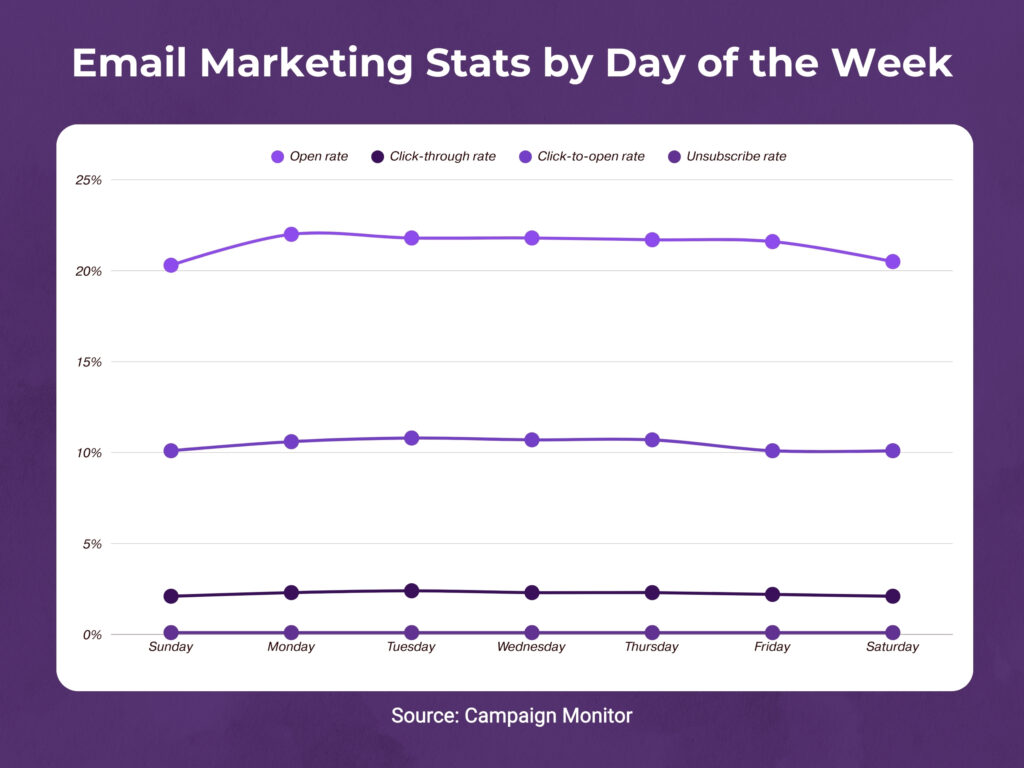
However, metrics like CTR (click-through rate), CTOR (click-to-open rate), and unsubscribe rates follow a different pattern. These tend to remain stable or even increase slightly on Tuesdays, making it a reliable day for engagement.
That said, weekends consistently show the lowest activity across all metrics. So, it’s best to avoid sending emails on Saturdays and Sundays according to their geographic time zone.
What is the best time to send an email?
According to marketing statistics, most email users are active during the morning. Email users are most active between the hours of 9 a.m. and 3 p.m.
Most email users tend to be active at this time, especially during the workweek. That’s when inboxes are being checked, meetings are happening, and people are more likely to glance at a new notification.
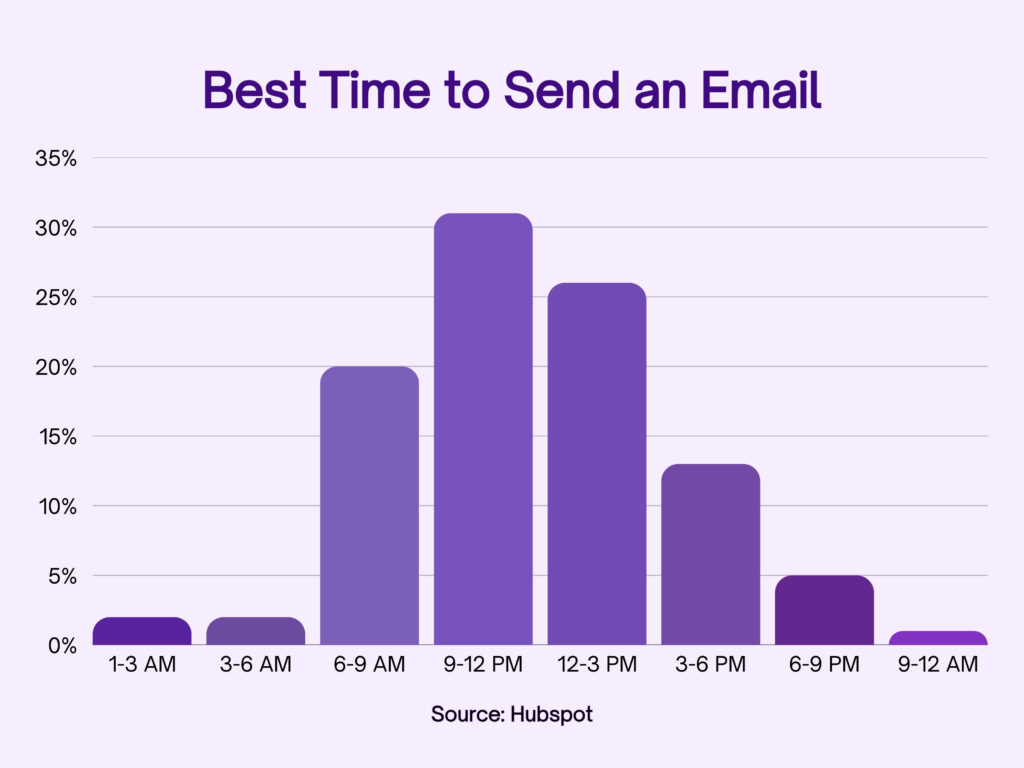
To increase your chances even more, try aiming for lunchtime, anywhere between 9 a.m. and 1 p.m. This is typically when people check emails at work, scroll through their phones, and are more open to reading something new.
How many emails should you send per month?
Retail and B2C sectors typically send 8-12 emails monthly, B2B and service-oriented industries prefer 2-6 emails monthly, and education, real estate, and dining sectors tend toward moderate frequencies (3-8 emails per month), according to Mailchimp.
Source: GetResponse
We can only recommend better practices based on statistics. If you look closely at the image above, you can conclude: fewer is better! We recommend keeping your email frequency as low as possible. It’s best to send 1-3 emails per month, but don’t go over 4.
So, choose accordingly, depending on your business type. But make sure you’re not over-emailing them.
The average email campaign gets 39% opens and $0.11 per subscriber. Top experts consistently pull 54%+ opens and $30K+ campaigns. We gathered insights from 16 experts, so you don’t have to!
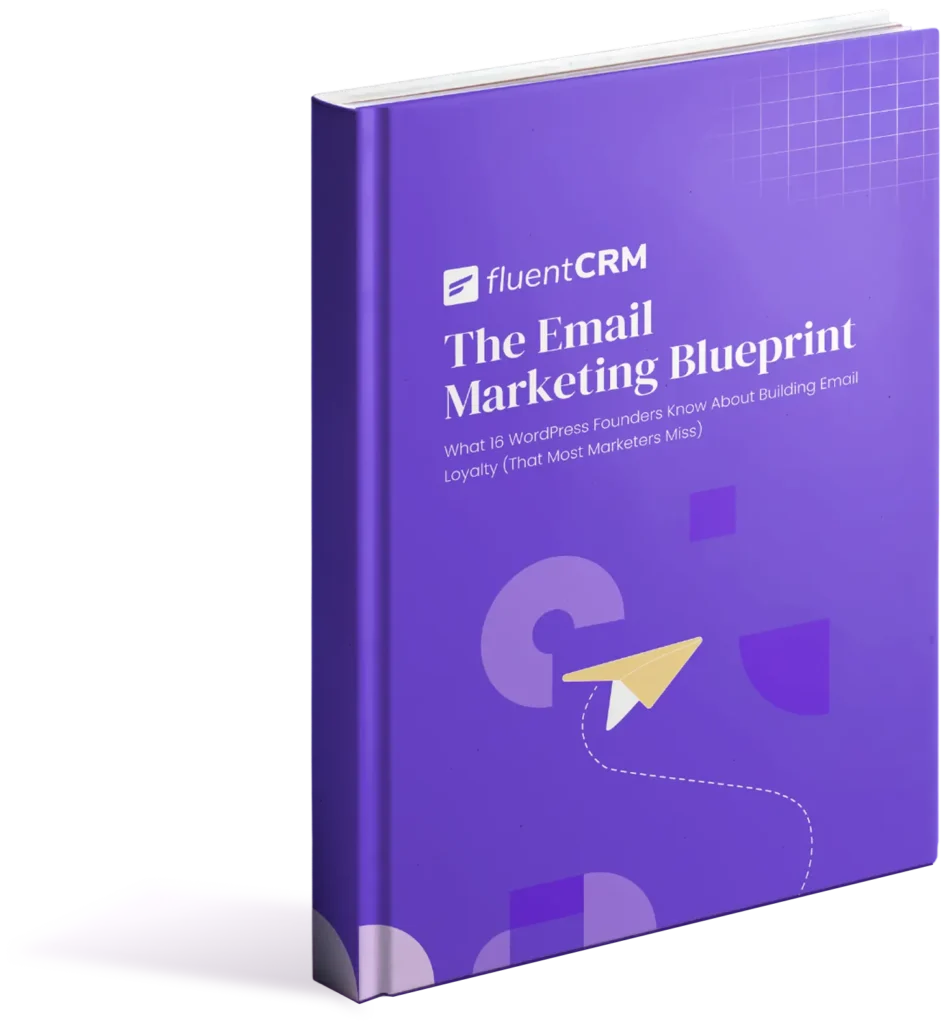
How does the frequency of your emails impact your ROI?
Keep in mind that when we say email frequency best practices, we solely mean the ideal approach! Anything above or below can hurt your email marketing campaign, company reputation, and many other things.
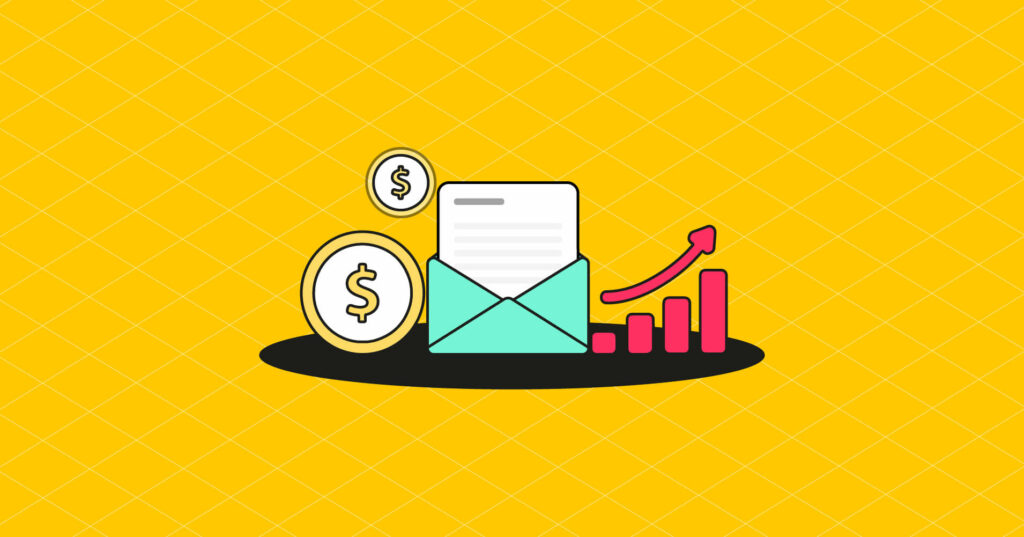
Although both under and over-emailing have different impacts, the outcome is the same: lower ROI! Let’s look at how these can hamper your overall effort.
Consequences of under-emailing
In the quest for accuracy, most email marketers make a common mistake. They often lower the number of emails so much that it affects them negatively.
Under-emailing or sending fewer than enough emails can:
- Reduce the customer’s interest: Customers expect emails from you at a regular interval. If you fail to provide relevant content regularly, your subscribers might lose interest in your brand.
- Lessen the inbox presence: If your email frequency gets too low, the subscribers may not recognize your company or might forget why they subscribe to your campaign in the first place.
- Affect the sender’s reputation: Spam filters often recognize infrequent emails from a particular email address. If you send emails infrequently, it might hamper your sender reputation.
- Unhelpful data for list cleaning: Email list cleaning is vital for maintaining the effectiveness of your email list. If you aren’t consistently sending emails, you won’t be able to identify abandoned email addresses, and hence, it’ll be harder to remove idle email addresses.
- Stall business growth: Under-emailing would lead potential customers to move away from your brand and not be informed about your products. Less customer means less business!
Consequences of over-emailing
In most cases, more has more negative consequences than less. Excessive emailing can permanently harm your email reputation and land you in spam traps.
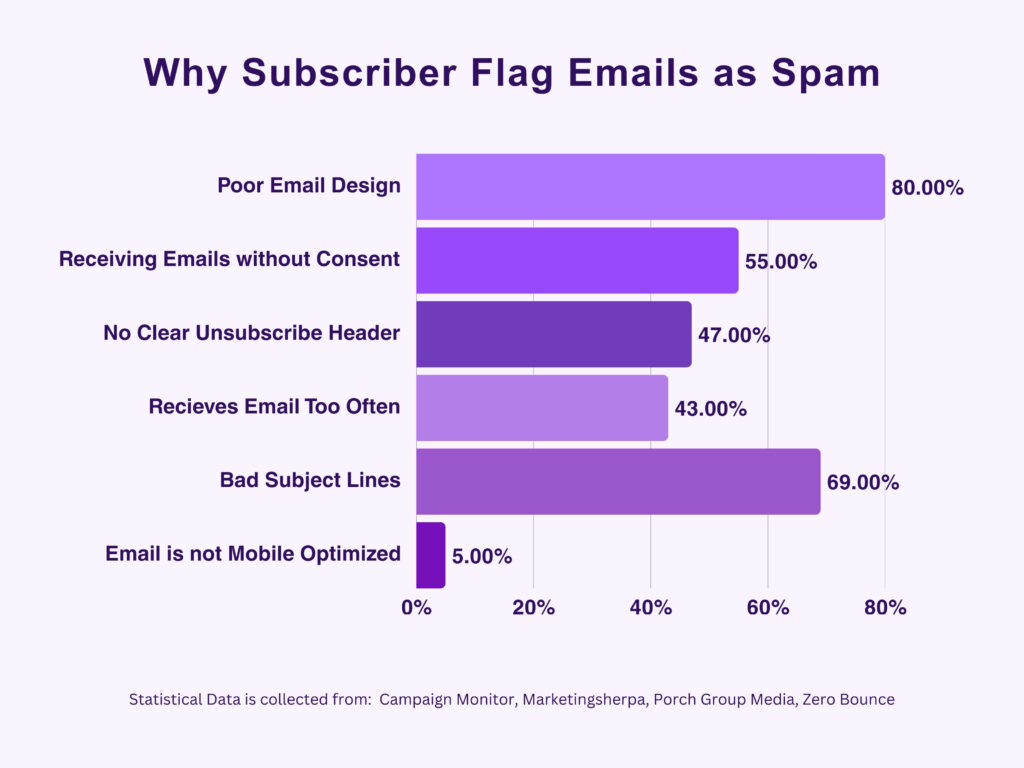
Let’s look at some of the consequences of excessive emailing.
- Reduce engagement: Don’t forget that they’re also receiving emails from other people. If you appear too frequently in their inboxes, they’ll begin to ignore you at some point, severely reducing your engagement rate.
- Affect sales and revenue: As your subscribers ignore you, your company’s revenue graph will begin to fall. Because they keep the majority of your emails unopened, the server will begin to mark you as undesired, and your emails will go to spam.
- Increase unsubscriptions: Do you know what the worst-case scenario is? Your recipients will eventually unsubscribe from your email list if they get annoyed.
- Increase spam rate: If you’re irritating your subscribers with too many emails, they may even mark your emails spam and cause permanent damage to your inbox placement rate.
In the End, It’s About Respecting the Inbox
Our quest for email frequency best practices has ended here! We hope you enjoyed the ride and found our article informative.
Oh, well, let us just give you some friendly advice before you leave!
There are no shortcuts in email marketing. Adhere strictly to the fundamentals, follow the procedure, determine your email frequency best practices, and sit at the top.
Enjoy your email marketing, and don’t forget to leave your thoughts in the comments section.
Cheers!
Nader Chowdhury
Hi! My name is Nader Ahmed Chowdhury, and I enjoy writing about WordPress and email marketing. Starting with sharing random musings on social media 10-12 years ago, I’m now a digital marketing strategist for FluentCRM and WPManageNinja. And what do I do when I’m not blogging? Well, you may still find me writing something pointless on social media!



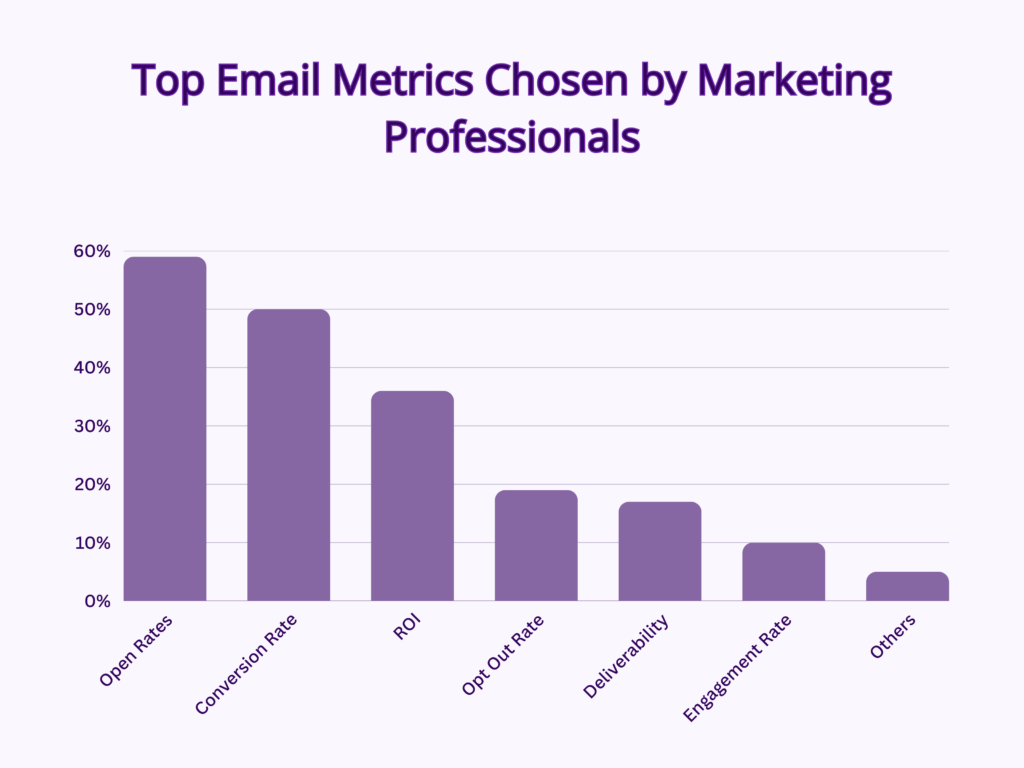

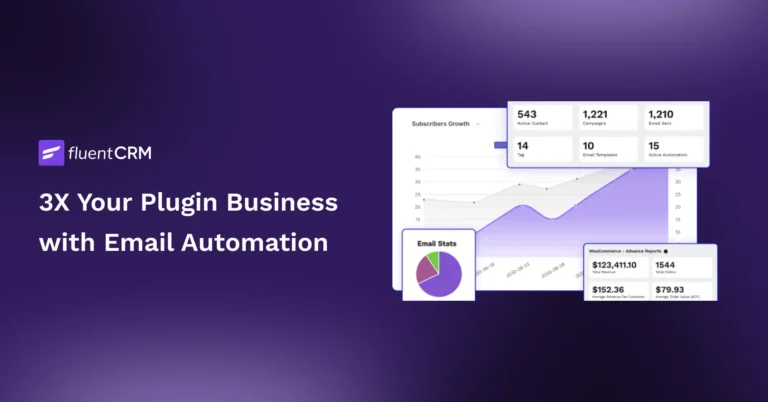
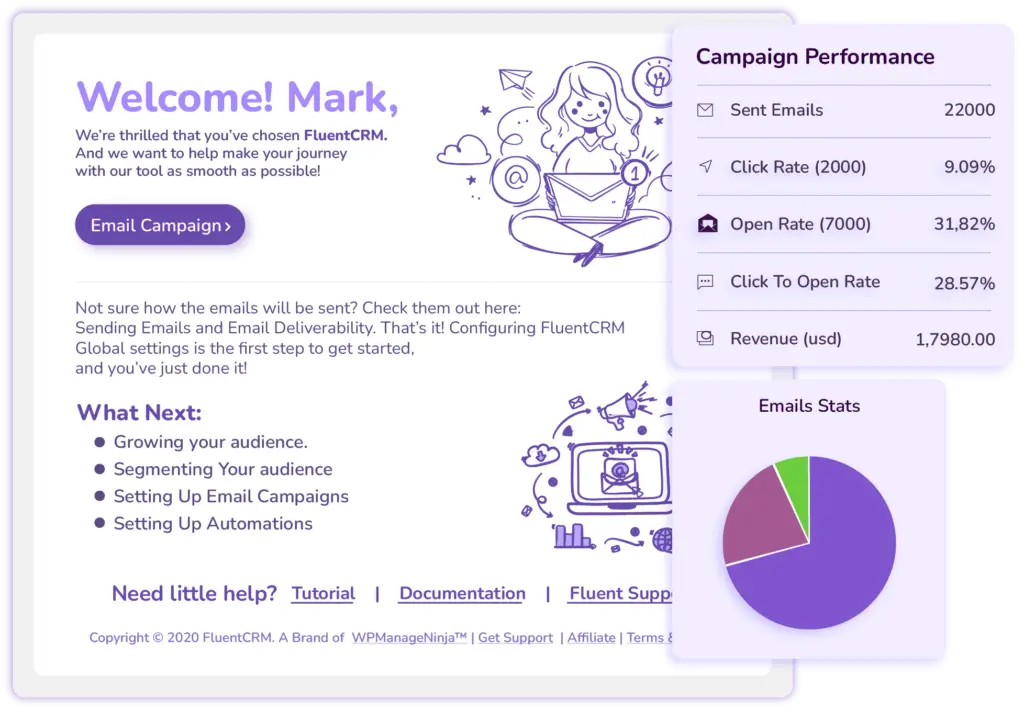
Leave a Reply